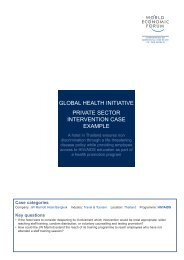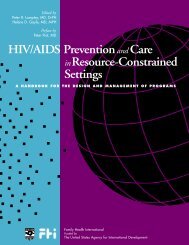The Training of Trainers Manual - UNFPA
The Training of Trainers Manual - UNFPA
The Training of Trainers Manual - UNFPA
You also want an ePaper? Increase the reach of your titles
YUMPU automatically turns print PDFs into web optimized ePapers that Google loves.
Handout 4 • STI Challenge 4<br />
1. Condoms are the most effective protection against the spread <strong>of</strong> sexually transmitted infections (STIs).<br />
FALSE<br />
■ Abstinence from sexual intercourse is the best way to prevent the spread <strong>of</strong> STIs.<br />
■ Condoms are the next best prevention, but only complete sexual abstinence is<br />
100 percent effective.<br />
2. Biologically, both men and women have an equal risk <strong>of</strong> acquiring an STI from a sexual partner.<br />
FALSE<br />
■ Women are more vulnerable to STIs than are men because women’s mucous membranes are<br />
larger and more sensitive. Small tears are common in the vagina.<br />
3. Women who take contraceptive pills are protected from pregnancy and STIs.<br />
FALSE<br />
■ Fluid exchange puts you at risk <strong>of</strong> contracting STIs. <strong>The</strong> pill is not a barrier that protects from<br />
fluid exchange.<br />
■ When taken consistently, the pill is an effective hormonal method for preventing pregnancy.<br />
4. Using two condoms at once (‘double bagging’) provides more protection against STIs.<br />
FALSE<br />
■ Condoms are made to be used alone – friction between two condoms can cause breakage.<br />
■ Do not combine a male condom with a female condom.<br />
5. Condoms are not always effective in preventing human papilloma virus (HPV), which causes<br />
genital warts.<br />
TRUE<br />
■ HPV can be transmitted by touching (hand to genital or genital to genital) an infected person’s<br />
lesions.<br />
■ Genital warts can be found on parts <strong>of</strong> the genitals (testicles, vulva) that are not covered or<br />
protected by a condom.<br />
■ Genital warts are transmitted during an outbreak. However, a person may not be aware that he<br />
or she is having an outbreak, since warts are not always visible.<br />
6. Someone infected with chlamydia usually has noticeable symptoms.<br />
FALSE<br />
■ Most people infected with chlamydia show no symptoms (the same is true for gonorrhoea).<br />
■ If left untreated (with antibiotics), chlamydia (and also gonnorhoea) can cause long-term<br />
complications (infertility and pelvic inflammatory disease in women and prostatitis in men).<br />
■ Symptoms: In women – pain or dull ache in cervix, heavy feeling in pelvic area, pain when<br />
urinating or during intercourse, heavier menstrual flow, heavy cervical discharge; in men –<br />
urethral discharge, pain when urinating, epididymitis.<br />
Section 4. Participant Handouts<br />
139

















